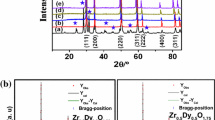Abstract
Ac impedance spectroscopy and neutron powder diffraction have been used to study the high temperature behaviour of defective fluorite solid electrolytes. In yttria-stabilised zirconia with an yttrium content of 15 mol% YO1.5 there is a marked change in conductivity behaviour at around 650 °C, with a decrease in activation energy of 0.15 eV. Structural studies confirm that this is due to a change in the bulk of the sample with the disappearance of diffuse scattering peaks and marked changes in the behaviour of the isotropic temperature factors at the same temperature. These results indicate that the change in activation energy of yttria-stabilised zirconia at 650 °C is due to an order-disorder transition involving local defect clusters. In studies of zirconia co-doped with yttrium and niobium, activation energy for conduction is found to rapidly increase with the concentration of the trivalent yttrium Saturation doping is reached at about 20–30 % of yttrium and activation energy only increases slightly with doping. Introduction of pentavalent niobium at this level of doping serves to decrease activation energy, although it also decreases conductivity slightly. The low and high temperature activation energies converge as the saturation regime is approached. These observations seem to suggest that ordering of defect clusters into microdomains increases activation energy for ionic motion. At low defect concentrations and high temperatures, this local ordering breaks down and the activation energy for conduction decreases.
Similar content being viewed by others
5. References
R.I. Smith and S. Hull, Report RAL-94-115, Rutherford Appleton Laboratory 1994.
W.I.F. David, R.M. Ibberson and J.C. Mathewman, Report RAL-92-032, Rutherford Appleton Laboratory 1992.
D.N. Argyriou, J. Appl. Cryst.27, 155–158 (1994).
V.F. Sears, Neutron News3[3], 26–37 (1992).
S.P.S. Badwal, J. Mat. Sci.20, 4593–4600 (1985).
S.P.S. Badwal, Solid State Ionics52, 23–32 (1992).
D.K. Honke, Solid State Ionics 5, 531–534 (1981).
J.E. Baurele and J. Hrizo, J. Phys. Chem. Solids30, 565 (1969).
A.S. Nowick and D.S. Park, in: Superionic Conductors, eds. G. Mahan and W. Roth (Plenum Press, New York 1976) 395–412.
A.S. Nowick, D.Y. Wang, D.S. Park and J. Griffith, in: Fast Ion Transport in Solids, eds. P. Vashishta, J.N. Mundy and G.K. Shenoy North Holland, Amsterdam 1979, 673–679
J.A. Kilner and C.D. Waters, Solid State Ionics6, 253–259 (1982).
J.A. Kilner and B.C.H. Steele, in: Non-stoichiometric Oxides, ed. O.T. Srensen (Academic Press, New York 1981) 233–269.
C.R.A. Catlow, Solid State Ionics12, 67–73 (1984)
B.C.H. Steele, in: High Conductivity Solid Ionic Conductors, (World Scientific, Singapore 1989) ed. T. Takahashi, 402–446.
C.R.A. Catlow, A.V. Chadwick, C.N. Greaves and L.M. Moroney, J. Am. Ceram. Soc.69[3], 272–277 (1986).
I.R. Gibson and J.T.S. Irvine, J. Mater. Chem., submitted.
D. Steele and B.E.F. Fender, J. Phys. C. Solid State Phys.7, 1–11 (1974).
M. Morinaga, J.B. Cohen and J. Faber Jr, Acta Cryst. A35, 789–795 (1979).
J.B. Cohen, M. Moringa and J. Faber Jr, Solid State Ionics3/4, 61–63 (1981)
R.E. Carter and W.L. Roth, in: Proc. Electromotive Force Measurements in High Temperature Systems, ed. C.B. Alcock (London Institution of Mining and Metallurgy, 1963) 125–144.
H. Horiuchi, A.J. Schultz, P.C.W. Leung and J.M. Williams, Acta Cryst.B40, 367–372 (1984).
B. Hudson and P.T. Moseley, J. Solid State Chem.19, 383–389 (1976).
N.H. Anderson, K. Claussen, M.A. Hackett, W. Hayes, M.T. Hutchings, J.E. MacDonald and R. Osborn, in: Proc. 6th Risø Int. Symp. on Metallurgy and Materials Science, eds. F.W. Poulsen et al (London Institution of Mining and Metallurgy, 1985) 279–284.
R. Osborn, N.H. Anderson, K. Claussen, M.A. Hackett, W. Hayes, M.T. Hutchings and J.E. MacDonald, Mater. Sci. Forum7, 55–62 (1985).
S. Hull et al, Solid State Ionics 28–30, 488–492 (1988).
R.B. Neder, F. Frey and H. Schulz, Acta Cryst.A46, 799–809 (1990).
R.D. Shannon and C.T. Prewitt, Acta Cryst.B25, 925–929 (1969).
J.G. Allpress and H.J. Rossel, J. Solid State Chem.27, 105–114 (1979).
Author information
Authors and Affiliations
Rights and permissions
About this article
Cite this article
Irvine, J.T.S., Gibson, I.R. & Fagg, D.P. Oxide ion transport in highly defective cubic stabilized zirconias. Ionics 1, 279–285 (1995). https://doi.org/10.1007/BF02390208
Received:
Issue Date:
DOI: https://doi.org/10.1007/BF02390208




